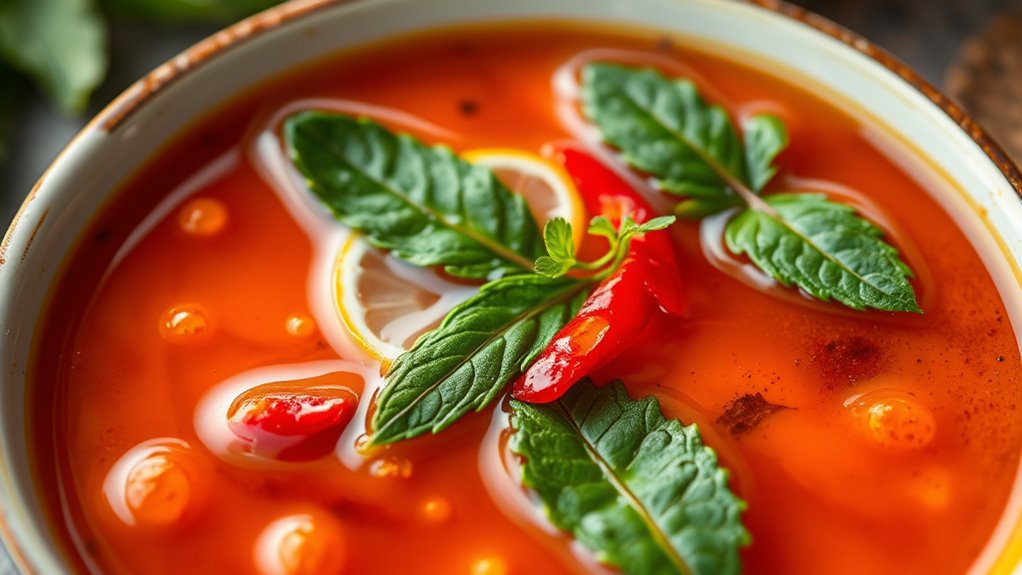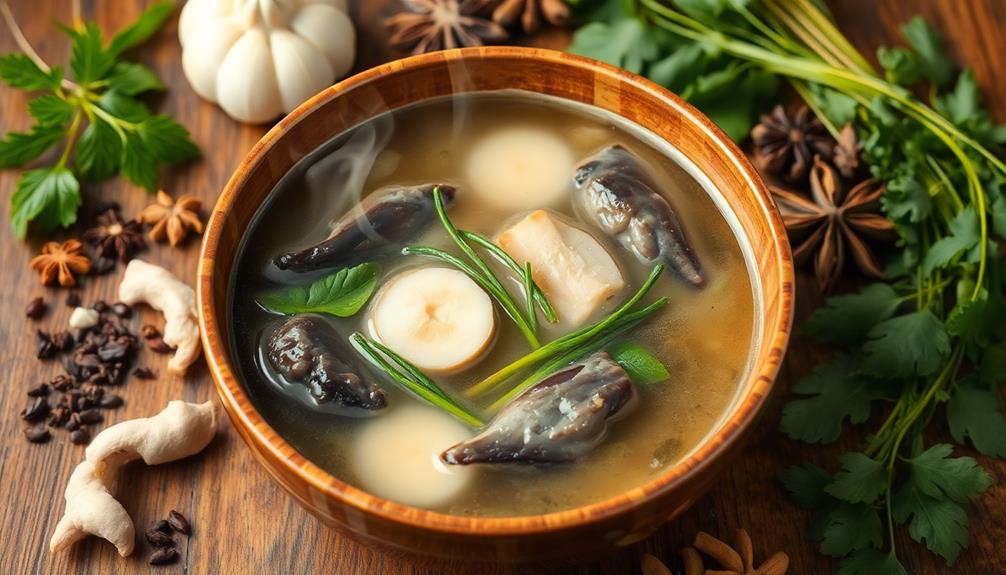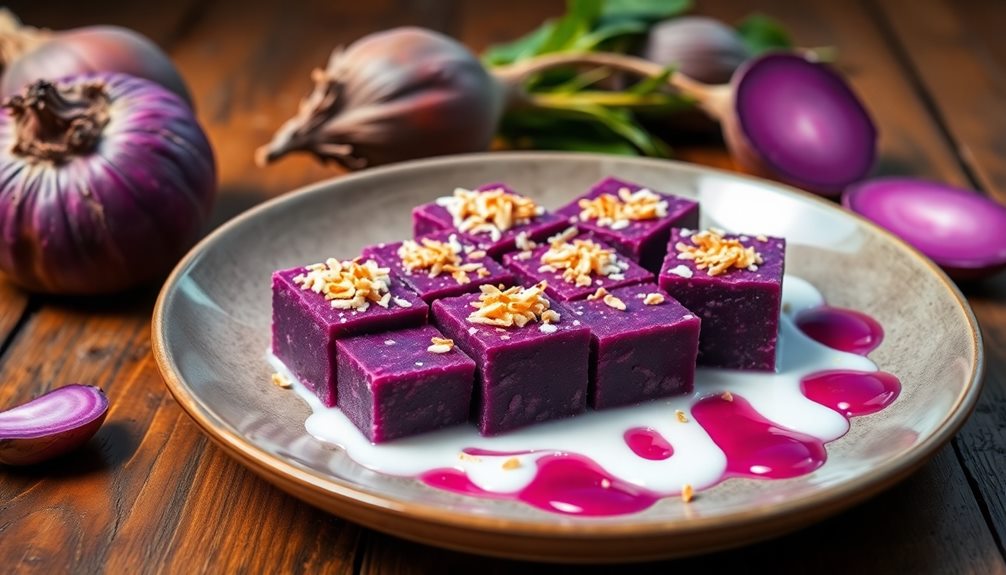To balance sour, sweet, and bitter in Nuoc Cham, start by tasting as you go and adjust ingredients gradually. Use fish sauce and lime juice to control sourness, adding sugar to dial down acidity and bring sweetness. If bitterness emerges, it’s usually from fermentation or ingredient choice—you can counter this with a pinch of sugar or more lime. Mastering these adjustments helps craft a harmonious sauce that enhances your dishes—explore further to refine your technique.
Key Takeaways
- Adjust lime juice and vinegar gradually to control sourness without overpowering other flavors.
- Incorporate small amounts of sugar to balance acidity and enhance overall sweetness.
- Use natural ingredients like fish sauce to add depth and mellow bitterness from fermentation.
- Taste frequently and fine-tune ingredients to achieve a harmonious blend of sour, sweet, and bitter notes.
- Remember that patience and incremental adjustments ensure a well-rounded, balanced Nuoc Cham.

Balancing the flavors of Nuoc Cham is vital to achieving its signature harmony of sweet, sour, salty, and spicy notes. To do this, you need to understand how the fermentation process influences the sauce’s flavor profile. During fermentation, the fish sauce develops complex umami notes, which serve as the backbone for balancing the other ingredients. The length of fermentation can vary, affecting how pungent or mellow the sauce becomes. A longer fermentation results in a richer, deeper flavor, while a shorter one produces a brighter, more pungent taste. As you experiment, you’ll learn how different fermentation durations impact the overall balance, helping you tailor your Nuoc Cham to your preferences. Additionally, understanding the role of natural materials like fish sauce and lime juice can help you better control the flavor profile. Recognizing the fermentation process can also guide you in selecting ingredients that complement the depth of flavor you desire. The quality and origin of these ingredients can significantly influence the final taste.
Mastering Nuoc Cham’s balance involves understanding fermentation’s impact on umami and flavor depth.
Ingredient variations also play a vital role in achieving harmony. Traditional recipes often call for fish sauce, lime juice, sugar, garlic, and chili, but you can adjust these ingredients to suit your taste. For example, using different types of fish sauce—some more pungent, others milder—can markedly alter the flavor balance. Similarly, the amount of sugar can be increased or decreased to control sweetness, which helps offset the sourness from lime or vinegar. You might also vary the chili’s heat level to add a spicy kick or opt for milder peppers if you prefer less heat. Every variation affects how the flavors interplay, so testing different combinations can help you find the perfect balance.
Understanding flavor balancing techniques can further refine your approach, ensuring a harmonious sauce every time.
When making Nuoc Cham, it’s important to taste as you go. Start with small adjustments, adding more lime juice for acidity or more sugar for sweetness, then wait a few minutes to allow the flavors to meld. Remember, the fermentation process continues subtly over time, influencing the sauce’s overall character. If you notice your sauce leaning too far in one direction—say, overly salty or too sour—you can balance it by adding a touch more sugar or a splash of water to dilute strong flavors. This iterative process guarantees you craft a well-rounded sauce that complements your dishes without overpowering them.
Practicing patience and keen observation are key to mastering this balancing act.
In essence, mastering the art of balancing Nuoc Cham involves understanding how fermentation shapes flavor development and how ingredient variations can fine-tune the taste. By paying attention to these elements, you gain control over the sauce’s profile, creating a condiment that enhances your meals perfectly. Whether you prefer a sweeter Nuoc Cham or one with a sharper tang, the key lies in thoughtful adjustments and patience. With practice, you’ll develop an intuitive sense of how each component contributes, allowing you to produce a harmonious, delicious Nuoc Cham every time.
Frequently Asked Questions
How Does Regional Variation Affect Nuoc Cham Flavor Balance?
Regional variation influences nuoc cham flavor balance because local ingredients and flavor preferences shape its taste. When you explore different areas, you’ll notice that the use of regional ingredients like lime, sugar, or fish sauce varies, affecting the sour, sweet, and bitter notes. These differences reflect local tastes and available produce, making each version uniquely suited to regional culinary traditions. This diversity allows you to experience a rich spectrum of nuoc cham flavors nationwide.
Can Nuoc Cham Be Adjusted for Low Sodium Diets?
If you’re adjusting nuoc cham for a low-sodium diet, you can use sugar alternatives like honey or agave to enhance sweetness without extra salt. Incorporate herbal infusions such as lemongrass or mint to add flavor complexity, reducing the need for salt. These adjustments help you maintain the traditional balance of sour, sweet, and bitter while making the sauce healthier and suited to your dietary needs.
What Are Common Substitutions for Fish Sauce in Nuoc Cham?
Imagine swapping out a key ingredient in a favorite recipe. For nuoc cham, you can use plant-based alternatives like soy sauce, mushroom soy, or homemade substitutes like tamari or coconut aminos. These options mimic fish sauce’s salty, umami flavor, making your sauce vegetarian or vegan-friendly. They’re common substitutions that help you keep the balance of sour, sweet, and bitter, even without traditional fish sauce.
How Does Aging Influence the Flavor Profile of Nuoc Cham?
Aging impacts nuoc cham through fermentation effects, which enhance flavor development over time. As it ages, you’ll notice deeper, more complex notes, and a richer umami taste. The fermentation process breaks down ingredients, mellowing sharpness and balancing sour, sweet, and bitter elements. This maturation allows the flavors to meld, creating a more harmonious and nuanced sauce that elevates your dishes and adds depth to the overall dining experience.
What Are the Best Storage Methods to Maintain Flavor Freshness?
To keep your nuoc cham fresh, store it in airtight containers to prevent contamination and preserve flavor. Use refrigeration methods, like placing the container in the coldest part of your fridge, to slow down spoilage. Make sure to seal it tightly after each use, and consume within a week for the best taste. Proper storage guarantees your nuoc cham maintains its vibrant sour, sweet, and bitter balance longer.
Conclusion
Think of your Nuoc Cham as a delicate symphony, where each flavor plays its part perfectly. When you balance sour, sweet, and bitter, you’re conducting a masterpiece that delights the senses. Just like a skilled maestro, trust your taste buds to guide you, adjusting each note until harmony is achieved. Remember, the magic lies in the details—so keep experimenting until your sauce sings with the perfect melody of flavor.









